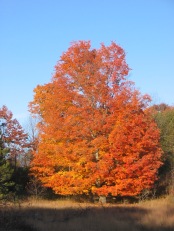
Aster cultivar ‘Purple Dome’
Asters, like their cousin Chrysanthemums, bloom in late summer through to the first frost. Their petals form rays around yellow centers of disk florets looking like the Latin translation of Aster, ‘star.’
Asters fit into almost any garden, Aster alpinus being a diminutive species that grows six to twelve inches, while certain Aster novae-angliae (New England Aster) and A. novi-belgii (New York Aster or Michaelmas daisy) cultivars can grow to six feet. These are the most popular perennial Asters for our area, although there are many other garden Asters. The annual aster, or China aster, however, is Callistephus chinensis and not the same genus, although they look similar.

Wildflower: Calico Aster
Many of our garden Asters started out as wildflowers and you can still find many varieties of the wildflower types like the Calico Aster blooming along our roadsides. The larger flowered, more colorful garden varieties came back to us improved by European growers and hybridizers. They retain their native hardiness, which makes them great additions for our gardens. You can find asters in single or double flowered forms, often borne in panicles, or several blossoms to each stem.
Aster alpinus, the Alpine aster, besides being lower growing, have a single one to two inch diameter yellow-centered bloom on each stem. They like our cooler summers and last longer here than in warmer areas. The flowers come in deep purple to lavender and pink.
Aster x frikartii is hardy only to zone 5, but with our snow cover that lasts most of the winter season; many gardeners may find it survives just fine. It is a cross between the Italian aster and the Thompson’s aster. It has large flowers with a prolonged season of bloom. ‘Monk,’ and ‘Wonder of Staffa,’ are probably the most popular aster cultivars grown. Both have blue flowers.
The wild New England aster is one of the largest and prettiest of the late summer-fall wildflowers. The garden cultivars have long and hairy leaves that clasp the stem (the bottom edges of the leaf wrap around the stem rather that attaching with a petiole). Flowers come in a range from white, pink, rose, deep red and violet-blue and make good cut flowers that last longer than the flowers of the New York aster.
Smooth rather than hairy leaves differentiate New York asters from New England asters. Their leaves also clasp the stem, but the number of cultivars numbers in the hundreds, ranging in size from fifteen inches to six feet. Flowers come in white, all shades of light to dark purple and blue, red and pink. Yellow is one color missing from Asters.

Wildflower: Panicled Aster?
Most Asters thrive in full sun, and although they’ll grow in partial shade, the amount of flowering is reduced. You can increase flowering by pinching stems tips back during the plant’s growth period, or until about the middle of June. It is important to deadhead the spent flowers as Asters set seed and the new plants won’t look like their parent. Tall growing varieties might need tying and staking to keep from flopping over. A layer of mulch helps retain moisture and keep weeds down, but most will thrive even if neglected.

Wildflower Smooth Aster
Plant centers might have blooming asters available in pots around this time of year, so look for a few autumn stars for your garden.



































Leave a comment
Comments feed for this article